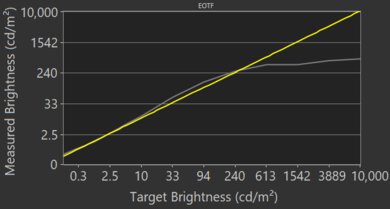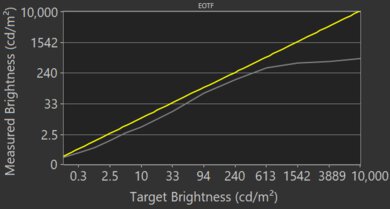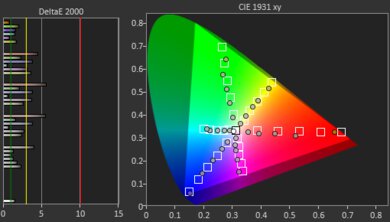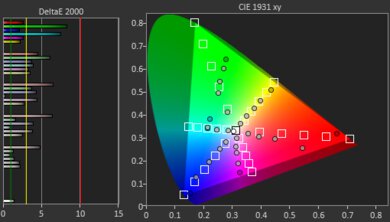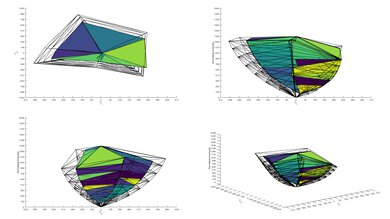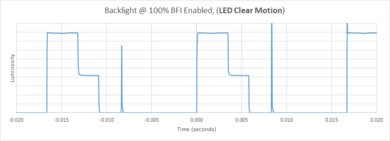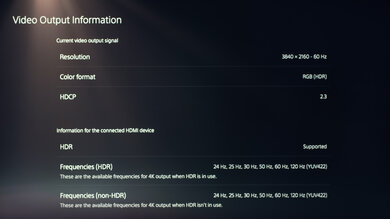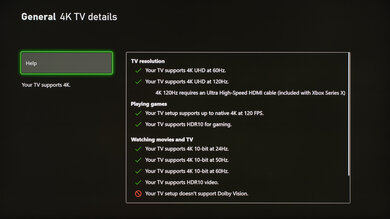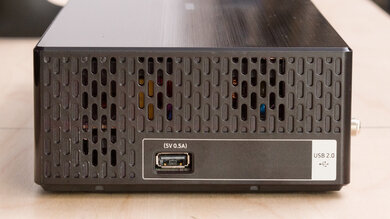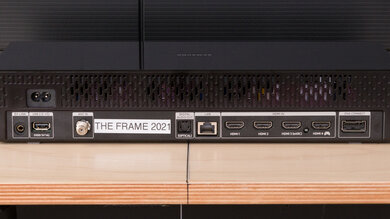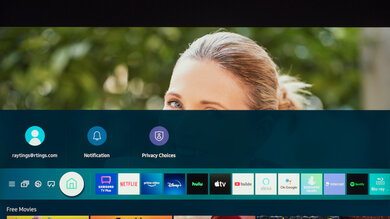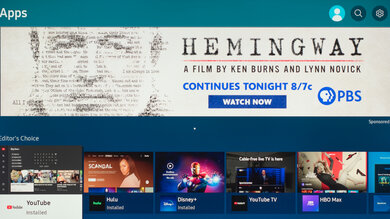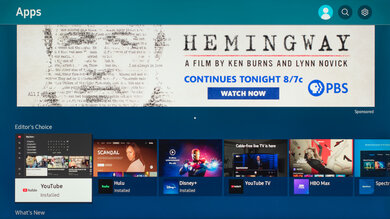The Samsung The Frame 2021 is the successor to the Samsung The Frame 2020, and it's a unique 4k TV with a VA panel and quantum dot technology. Its main selling feature is its unique design, as it's intended to be wall-mounted and can display artwork when you're not using it. Samsung even sells frames for it that make it look like a framed painting when wall-mounted. Its VA panel delivers deep, uniform blacks, making it a great choice for a dark room. It has great peak brightness in SDR and decent reflection handling, so it can handle a bright environment as long as there's no direct sunlight. It has a few great gaming features, including an HDMI 2.1 port for 4k @ 120Hz gaming and variable refresh rate support. Sadly, it has narrow viewing angles, and HDR doesn't add much, as it has no local dimming feature and just okay peak brightness in HDR.
Our Verdict
The Samsung The Frame TV is a good TV overall. It's well-suited for watching TV shows and sports due to its high peak brightness and decent reflection handling. It has a great response time, 120Hz refresh rate, low input lag, and VRR support, making it a good option for gaming and use as a PC monitor. It has a high contrast ratio to produce deep blacks, which is great for watching movies in the dark, but sadly, it lacks local dimming, and it doesn't get very bright in HDR, so highlights don't pop the way they should.
- Displays deep blacks.
- Great response time.
- Gets bright enough to fight glare.
- Narrow viewing angles.
- Doesn't handle direct reflections well.
The Samsung The Frame TV is decent for watching movies. It has an outstanding contrast ratio that makes it a great choice for dark rooms. It upscales lower resolution content without any issues, and it removes judder from all sources. Unfortunately, it doesn't have local dimming, and low frame rate content like movies stutters a bit due to its quick response time.
- Displays deep blacks.
- Upscales lower resolution content without issues.
- Removes judder from all content.
- No local dimming.
- Stutters a bit in low frame rate content.
The Samsung The Frame TV is good for watching TV shows. It has decent reflection handling and gets pretty bright, so it can handle bright rooms well, as long as there's no direct sunlight. It upscales lower resolution content without any issue, and it has excellent smart features with plenty of apps available. Unfortunately, it has narrow viewing angles, which isn't ideal if you like walking around while watching.
- Gets bright enough to fight glare.
- Upscales lower resolution content without issues.
- Excellent interface with lots of apps.
- Narrow viewing angles.
- Doesn't handle direct reflections well.
The Samsung The Frame TV is good for watching sports. It has a great response time to deliver a clear image in fast-moving scenes, and it has a black frame insertion feature to further improve motion clarity. It handles reflections decently well and gets bright enough to combat glare. However, it has narrow viewing angles that cause the image to appear washed out when viewed from the side, so it's not the best for watching with a big group of people.
- Great response time.
- Gets bright enough to fight glare.
- Upscales lower resolution content without issues.
- Narrow viewing angles.
- Doesn't handle direct reflections well.
The Samsung The Frame TV is good for gaming. It has an HDMI 2.1 port, so it supports 4k @ 120Hz gaming from a PC and variable refresh rate technology. It has a great response time to deliver clear motion, and its low input lag makes gaming feel incredibly responsive. It has an outstanding contrast ratio to display deep blacks, making it great for dark rooms, but it doesn't have a local dimming feature to further improve black level. Sadly, 4k @ 120Hz gaming isn't currently working properly from the new consoles.
- Displays deep blacks.
- Great response time.
- Can display 4k @ 120Hz.
- VRR support.
- No local dimming.
- Doesn't handle direct reflections well.
The Samsung The Frame TV is decent for watching movies in HDR. It has an outstanding contrast ratio and amazing black uniformity, resulting in deep blacks, one of the most important factors in a good HDR experience. Sadly, there's no local dimming feature, and it can't get bright enough for small highlights to stand out the way they should. While HDR does make a noticeable difference on this TV, it's not as good as it should be.
- Displays deep blacks.
- Removes judder from all content.
- No local dimming.
- Stutters a bit in low frame rate content.
- Not bright enough for a true HDR experience.
The Samsung The Frame TV is good for gaming in HDR, mainly due to its very good gaming performance. It has low input lag and a great response time, resulting in a responsive gaming experience with little blur, and it supports VRR for a nearly tear-free gaming experience. Sadly, HDR doesn't add much, as it can't get bright enough to deliver a true HDR experience, and it doesn't have a local dimming feature.
- Displays deep blacks.
- Great response time.
- Can display 4k @ 120Hz.
- VRR support.
- No local dimming.
- Doesn't handle direct reflections well.
- Not bright enough for a true HDR experience.
The Samsung The Frame TV is great for use as a PC monitor. It has low input lag to provide a responsive desktop experience, and it supports most common resolutions as well as chroma 4:4:4. Visibility is good in well-lit rooms due to its decent reflection handling and high peak brightness. However, like most VA panel TVs, it has narrow viewing angles, so the image looks inaccurate at the sides if you sit up close.
- Great response time.
- Supports most common resolutions and chroma 4:4:4.
- Gets bright enough to fight glare.
- Narrow viewing angles.
- Doesn't handle direct reflections well.
Changelog
- Updated Jul 08, 2025: We uploaded the latest brightness measurements and uniformity photos for the Accelerated Longevity Test.
- Updated Apr 17, 2025: We uploaded the latest brightness measurements and uniformity photos for the Accelerated Longevity Test.
- Updated Feb 11, 2025: We uploaded the latest brightness measurements and uniformity photos for the Accelerated Longevity Test.
- Updated Nov 20, 2024: We uploaded the latest brightness measurements and uniformity photos for the Accelerated Longevity Test.
Check Price
Differences Between Sizes And Variants
We tested the 55 inch Samsung The Frame 2021 (QN55LS03AAFXZA), and we expect the results to be valid for the 65 inch, 75 inch, and 85 inch models. The 43 inch and 50 inch models have a 60Hz refresh rate and don't support a variable refresh rate, but most of our results should still be valid for those sizes.
| Size | US Model | Short Model Code | Refresh Rate | Variable Refresh Rate |
|---|---|---|---|---|
| 43" | QN43LS03AAFXZA | QN43LS03A | 60Hz | No |
| 50" | QN50LS03AAFXZA | QN50LS03A | 60Hz | No |
| 55" | QN55LS03AAFXZA | QN55LS03A | 120Hz | Yes |
| 65" | QN65LS03AAFXZA | QN65LS03A | 120Hz | Yes |
| 75" | QN75LS03AAFXZA | QN75LS03A | 120Hz | Yes |
| 85" | QN85LS03AAFXZA | QN85LS03A | 120Hz | Yes |
If you come across a different type of panel or your Samsung The Frame doesn't correspond to our review, let us know, and we'll update the review. Note that some tests, like gray uniformity, may vary between units.
Our unit was manufactured in February 2021; you can see the label here.
Popular TV Comparisons
The Samsung The Frame is a good TV overall with a unique design. However, unless you need its Art Mode feature and customizable bezels, there are much better TVs in its price range, like the Samsung QN85A QLED.
For more options, check out our recommendations for the best 4k TVs, the best QLED TVs, and the best 4k HDR TVs.
The Samsung The Frame 2022 is a newer version of the Samsung The Frame 2021. Both TVs are very similar overall, and the main difference is that the 2022 model has a different screen coating. The 2022 version has a matte finish, while the 2021 version has a semi-glossy finish. The matte finish reduces the intensity of mirror-like reflections and makes the screen look more like a realistic piece of art. The 2022 TV also has better out-of-the-box accuracy, but other than that, both TVs are very similar.
The Samsung The Frame 2021 is the successor to the Samsung The Frame 2020. They perform similarly for the most part; however, the 2020 model has a much higher contrast ratio and a better color gamut. The 2021 model has slightly better response times, and its backlight flickers at a much higher frequency, resulting in less image duplication in fast-moving content.
The Hisense H9G is much better than the Samsung The Frame 2021 for most uses. The Hisense has a higher contrast ratio, full-array local dimming, and a wider color gamut. It also has better reflection handling and gets significantly brighter. Its response time is faster, but unlike the Samsung, it's limited to a 60Hz refresh rate at 4k because it doesn't have any HDMI 2.1 ports. The Samsung has lower input lag, and it supports VRR to reduce screen tearing.
The Sony X900H is better than the Samsung The Frame 2021 overall, especially for watching movies and HDR content. It's because it has a full-array local dimming feature, gets a bit brighter in HDR, and its gradient handling is much better. It has a slightly better response time than the Samsung, but its input lag is higher. Unlike the Sony, the Samsung doesn't support Dolby Vision; it supports HDR10+ instead.
Test Results

The Samsung The Frame's design is very similar to its predecessor, the Samsung The Frame 2020. It still features the One Connect box so that there's only a single cable leading to the TV, but the TV itself is much thinner than the 2020 model, and the feet have been slightly redesigned to allow for height adjustment. The picture shown is with the feet at their lowest position. The borders are customizable. The TV comes with black ones, and you can change them to beige, brown, or white, although you have to purchase them separately and install them yourself.
The feet aren't reversible, but they're height-adjustable so that you can fit in a soundbar or a flat console like the Xbox Series S without obstructing the screen. They lift the TV by about 3.5 inches. They're very sturdy, and the TV doesn't wobble much. You can also mount the TV on a studio stand, like a painting on an easel, although the stand is sold separately.
Footprint of the 55 inch stand: 35.2" x 9".
The back is plastic and has etched horizontal lines that feel more prominent than on the 2020 model. There are cable management tracks to guide the One Connect cable towards the feet or down the middle. The no-gap wall mount is included.
The borders are slightly thicker than other 2021 Samsung QLED TVs but are still very thin. You can customize the bezels so that they fit in better with your existing decor. However, you have to purchase the white, beige, or brown ones separately, and you have to install them yourself.
The Samsung The Frame TV's build quality is excellent. It feels well-built overall, and it doesn't flex or wobble much. However, it requires a lot of force to push the plastic piece covering the One Connect port on the TV inwards enough to plug the cable. Also, the borders seem to scratch easily, and they feel loose as if they might fall off. That said, these might be issues that are only present on our unit. If you have this TV and experienced the same issues, let us know in the discussions.
The Samsung The Frame has outstanding contrast, resulting in deep blacks when you're in a dark room, as expected for a VA panel. Sadly, there's no local dimming feature to improve contrast. Contrast can vary between individual units, but these results are about what we expect from any VA panel on the market.
The Samsung The Frame TV has impressive SDR brightness. It's very similar to the Samsung The Frame 2020, but small highlights aren't dimmed unnecessarily by the TV's CE dimming (also known as Frame dimming). It's bright enough to overcome glare in most viewing environments, as long as there's no direct sunlight on it.
We measured the SDR brightness after calibration in the 'Movie' Picture Mode with the Color Tone set to 'Warm 2' and Brightness set to max.
If you want a brighter image and don't mind losing a bit of image accuracy, set the Picture Mode to 'Dynamic' and Brightness to max. We reached 590 cd/m² in the 10% window with these settings.
This TV doesn't have a local dimming feature. We still film these videos on the TV, though, so you can compare the backlight performance with a TV that has local dimming.
This TV doesn't have a local dimming feature. We still film these videos on the TV, though, so you can compare the backlight performance with a TV that has local dimming.
The HDR brightness is okay. It's not quite as bright as the Samsung The Frame 2020, but unlike its predecessor, it's more consistent as there's no dimming in the 2% windows. It's bright enough to bring out some highlights, but not for a true cinematic HDR experience.
We measured the HDR brightness in the 'Movie HDR' Picture Mode with Contrast and Brightness set to max, Color Tone set to 'Warm 2', and all other processing disabled. We reached 633 cd/m² in the 10% window using the 'Dynamic HDR' Picture Mode, with Contrast and Brightness at max, and Contrast Enhancer set to 'High'.
The EOTF follows the target curve well in dark scenes, but bright scenes are over brightened, and the roll-off near the TV's peak brightness isn't at all smooth. If you find HDR content too dim, set Contrast Enhancer to 'High' and ST.2084 to max. These settings result in a much brighter image, as you can see in this EOTF plot.
The HDR brightness in Game Mode is a bit brighter than outside of Game Mode, but there's frame dimming in the 2% windows, which means small highlights in dark scenes appear dimmer. The EOTF doesn't follow the curve as well as outside of Game Mode; all scenes appear darker than they should. If you want to make HDR brighter in Game Mode, set Contrast Enhancer to 'High' and ST.2084 to max.
We measured the HDR brightness in Game Mode with Brightness and Contrast at max, Color Tone set to 'Warm 2', Color Gamut set to 'Auto', and all other processing disabled.
This TV has good overall gray uniformity, but this can vary between individual units. All four sides are a bit darker than the center on our unit, and there's some distracting dirty screen effect in the center. Overall, it's not too bad, but it's noticeable when watching sports.
Despite the absence of a local dimming feature, the Samsung The Frame we bought has fantastic black uniformity. There are a few cloudy spots noticeable throughout the screen, but they're hardly noticeable. There's very little blooming around the bright cross at the center of the screen, which is impressive.
As is expected of most VA panel TVs, this TV has sub-par viewing angles. It's better than the Samsung The Frame 2020, but the image still looks inaccurate when viewed from the side, so it's not ideal for a wide seating arrangement. The 43 and 50 inch models are advertised to have worse viewing angles, but we're not sure by how much.
The Samsung The Frame TV has decent reflection handling. It's fine for most viewing environments, but if you have a lot of direct sunlight, it's not bright enough to overcome it. The newer Samsung The Frame 2022 QLED has a matte finish meant to reduce the amount of direct reflections and make the artwork look more realistic, if that's what you prefer.
The Samsung The Frame TV has okay accuracy out of the box. Most colors and shades of gray are visibly inaccurate. The color temperature is on the colder side, which gives the image a blueish tint. Gamma doesn't follow the 2.2 target, resulting in most scenes appearing brighter than they should. Note that accuracy varies between units.
After calibration, this TV has exceptional accuracy. Gamma follows our 2.2 target nearly perfectly. There are a few remaining inaccuracies with highly saturated reds and blues, but most people won't notice it. White balance is almost perfect, and the few remaining issues aren't noticeable. Finally, the color temperature is nearly perfect, and the blueish tint that was there out of the box is gone.
You can see our recommended settings here.
The Samsung The Frame TV uses a BGR subpixel layout. This has no noticeable impact on picture quality, but it can cause blurry text in some applications when using the TV as a PC monitor. You can read more about it here.
The Samsung The Frame has a very good color gamut. It has excellent coverage of the DCI P3 color space used by most current HDR content. Coverage of the wider Rec. 2020 color space is mediocre, but it can display a wide color gamut. Sadly, the TV's tone mapping is worse than the Samsung The Frame 2020, especially in the reds, which have a noticeably pink tint.
The color volume is okay. It mostly has difficulty displaying bright colors due to its limited HDR peak brightness. Despite the high contrast ratio, it can't display dark saturated colors well, either, but this isn't very noticeable.
This TV has decent gradient handling, but there's some noticeable banding. The banding is worse in dark grays, reds, and greens. Enabling Noise Reduction helps reduce banding with low-quality content, but it's not as effective as most of the other Samsung TVs we've tested in 2021. Note that we don't recommend leaving this setting enabled, as it results in a loss of fine details when watching high-quality content.
We don't expect VA panels to experience permanent image retention, as the VA panel in our long-term test appears immune.
The response time is great, resulting in very little blur behind fast-moving objects. It's very similar to the Samsung The Frame 2020, but there's less image duplication because its backlight flickers at a much higher frequency than its predecessor. Unfortunately, like most VA panels, dark scenes have a significantly slower response time and more overshoot, resulting in a longer trail behind dark objects, commonly known as black smear.
The Samsung The Frame TV uses pulse-width modulation (PWM) to dim the backlight, but it behaves quite differently from the other Samsung TVs we've tested in 2021. It flickers at 960Hz in the 'Movie' Picture Mode, which won't bother most people. It drops to 480Hz in Game Mode and 120Hz in the Dynamic, Natural, Standard, and Filmmaker Picture Mode. It also flickers at 120Hz when Picture Clarity or Game Motion Plus is enabled.
The Samsung The Frame TV has a backlight strobing feature, commonly known as black frame insertion, to improve motion clarity. The timing of the backlight pulse is slightly off, though, causing a slight image duplication in some content. The BFI score is based on the refresh rates that support BFI and doesn't reflect how well the BFI feature actually works.
The Samsung The Frame TV can interpolate lower frame rate content up to 120Hz to make motion appear more fluid. To use it, set Picture Clarity to 'On', then adjust the Blur Reduction slider for 60fps content or the Judder Reduction slider for lower frame rate content. It looks okay when enabled, and it doesn't stop interpolating in busy scenes. However, there are a fair amount of artifacts in fast-moving scenes, and even some in quiet scenes.
There's some stutter in low frame rate content due to the TV's relatively quick response time. This is mainly noticeable in slow panning shots when watching movies. If stutter bothers you, enabling motion interpolation may help.
The Samsung The Frame TV can remove judder from all sources.
The Samsung The Frame TV supports FreeSync variable refresh rate technology to reduce screen tearing when gaming. It doesn't officially support G-SYNC compatibility, although some users have reported that it works. We tried it with our RTX 3070 at 60Hz and 120Hz; there was a lot of tearing in our pendulum demo, but none in Destiny 2. It's similar to the Samsung QN90A QLED's behavior.
Note: The 43 inch and 50 inch models have a 60Hz refresh rate and don't support VRR.
The Samsung The Frame TV has exceptionally low input lag to provide a responsive gaming or desktop experience. To get the lowest latency, enable Game Mode. Unlike most other brands, Samsung has a motion interpolation feature that's designed for use in 'Game' mode, and it has surprisingly low input lag.
Like the Samsung QN90A QLED, we can't test the input lag with VRR because we're getting incorrect readings of 1 ms, and VRR doesn't seem to be working properly with the RX6800 and RX580 graphics cards. We'll continue to investigate this issue and provide an update. We don't expect the input lag to increase with VRR enabled.
The Samsung The Frame TV supports most common resolutions. Except for 1440p @ 120Hz, chroma 4:4:4 is displayed properly in any other supported resolution, which is essential for clear text when using the TV as a PC monitor.
Update 11/11/2021: We received reports that updating the firmware to version FW 1566 breaks the HDMI 2.1 support. We updated our TV to the latest firmware (FW 1805), and we checked to see if anything changed with the Xbox Series X. Although the TV still supports 40 Gbps bandwidth, we noticed issues where the Xbox was dropping 4k @ 120Hz 10-bit signals in Destiny 2 and War Zone. Even after setting the refresh rate to 60Hz, it would continue to drop the signal. Let us know if you experience the same thing.
The Samsung The Frame has an HDMI 2.1 port and supports up to 4k @ 120Hz with HDR on the PS5 and Xbox Series X, but there are some issues with the Xbox with the latest firmware update. It has an Auto Low Latency Mode that enables Game Mode when a game is launched from a compatible device. To use it, set Game Mode to 'Auto'. Like many 2021 Samsung TVs, there's now a Game Bar that shows current game settings like input lag, VRR, and HDR.
Update 11/11/2021: We received reports that updating the firmware to version FW 1566 breaks the HDMI 2.1 support. We updated our TV to the latest firmware (FW 1805), and we checked to see which resolutions it supports. It still works with 4k @ 120Hz signals with proper chroma 4:4:4, and any other HDMI 2.1 signal from our PC, like 4k @ 120Hz with 10 and 12-bit color depth. We also confirmed it still supports 40 Gbps bandwidth, as you can see here. However, there were issues with 4k @ 120Hz HDR games from the Xbox Series X, which is explained in the Advanced Console Compatibility section.
This TV supports eARC, which means you can pass high-quality, uncompressed audio to an external home theater system over an HDMI connection.
Unfortunately, like most TVs, the Samsung The Frame's built-in speakers are mediocre. The low-frequency extension is very high, so the TV can't produce any thump or rumble in its bass. Above the LFE, the frequency response is well-balanced, resulting in clear dialogue. It gets decently loud, but there's a bit of compression at max volume.
The distortion performance is okay. The amount of harmonic distortion is very low at moderate volume levels, but it increases when nearing max volume. That said, some people may not hear it, and it depends on the content.
The Samsung The Frame TV has a great smart interface. It runs Samsung's proprietary smart interface, known as Tizen. It's very smooth and easy to use, and it has a huge selection of streaming apps.
Samsung content store has a huge selection of streaming apps, so you're sure to find your favorite streaming service. Like its predecessor, the highlight feature is its Art Mode, which displays artwork or photos when the TV isn't in use. You can learn more about it here.
Like other 2021 Samsung QLED TVs, the remote has been slightly redesigned. It now has a rechargeable battery instead of disposable ones, and you can recharge it through the solar panel on the back or the USB-C port at the bottom, but it doesn't come with a charger or cable. It has a built-in microphone for voice control, which you can use to change inputs, launch apps, or adjust a few settings on the TV. Unfortunately, it can't search within apps for specific content.









